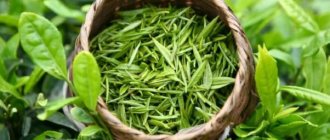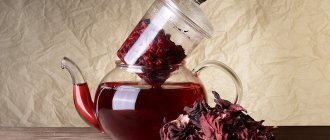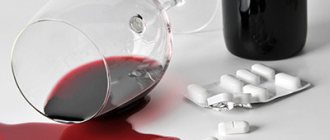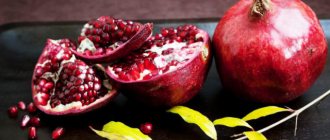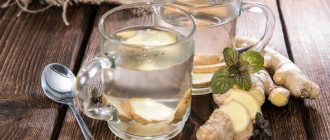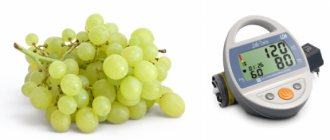Green tea is a drink loved by many. Thanks to its pleasant taste and aroma, people drink tea to improve their mood and get a boost of energy when hot, and when cold to eliminate thirst and restore water balance in the body. Tea leaves are widely used in medicine and cosmetology as a means for weight loss.
However, hypertensive people often wonder how green tea affects blood pressure, whether it is recommended for people with this diagnosis to drink it, or whether it is worth limiting the amount of drink. Today we need to understand the beneficial properties of green tea leaves, methods of preparation and rules for consumption by people with high and low blood pressure.
Beneficial properties of green tea for hypertensive patients
Green tea lowers blood pressure through three main actions:
- Diuretic;
- Anticholesterol;
- Tonic.
Vessels cannot hold an infinite amount of blood. And its amount depends on how much a person drinks and how long the liquid is retained in the body. The more water you drink, the greater your blood volume.
There is excessive pressure on the vascular walls, which leads to an attack of hypertension. Green tea prevents stagnation by quickly removing excess fluid through the kidneys. Accumulated cholesterol also causes high blood pressure. Imagine a hose. The outer diameter remains constant, and the inner diameter gradually decreases as it becomes dirty.
The amount of water supplied remains the same. Then the walls of the hose experience excessive pressure and may even be damaged. Green tea clears the lumens of veins, arteries and capillaries from cholesterol plaques and keeps them healthy.
The tonic effect of the drink is to expand and strengthen blood vessels. Imagine that, with a constant amount of incoming water, the clearance of the hose suddenly increases. Then the pressure drops. And this is what a hypertensive patient needs.
Symptoms of high blood pressure
High blood pressure never goes unnoticed by a person. As soon as it begins to grow, the following symptoms appear:
- headaches localized in the back of the head;
- tinnitus;
- nausea;
- dyspnea;
- dizziness;
- purple complexion.
A short-term increase in blood pressure can occur due to stress or as a result of another psychological shock. In other cases, an increase in tonometer values is a reason for a comprehensive examination. Hypertension most often develops gradually. This manifests itself as fatigue and poor health, as well as sleep disturbances. It is important to measure blood pressure during headaches in order to notice its increase in time.
Beneficial components of green tea
The beneficial properties of the drink are due to its chemical composition:
- Tannin. Gives a characteristic taste and strengthens the walls of blood vessels.
- Thein. This substance is a relative of caffeine. But unlike the latter, it is not harmful to the heart, because it acts gently and is quickly eliminated from the body. But during this time, theine manages to invigorate the body and improve cerebral circulation.
- Catechin is a natural antioxidant. Promotes weight loss, lowering blood sugar and eliminating other factors that cause the development of hypertension.
- Glutamic acid and other amino acids. These are small building blocks of our body, replacing old cells. Regular renewal of vascular tissue leads to maintaining the elasticity of the walls and reducing blood pressure.
Green tea contains vitamins:
- Carotene (provitamin A). Keeps the lumen of blood vessels clear.
- Ascorbic acid (vitamin C). Strengthens the walls.
- Thiamine, riboflavin and niacin (vitamins B1, B2 and B3). Participate in metabolic processes and reduce the amount of cholesterol.
- Tocopherol (vitamin E). Responsible for the elasticity of tissues.
This is interesting! In 1996, an experiment was conducted in China in which two groups of people took part. In the first one, it was allowed to eat unhealthy foods, but it was necessary to drink several cups of green tea. In the second, this drink was prohibited, but the subjects had to adhere to the rules of a healthy diet. As a result of the experiment, it turned out that the condition of the cardiovascular system was better in the first group. Their risk of developing hypertension was reduced by 50% compared to adherents of a healthy lifestyle.
Useful qualities of the drink
The product includes many useful qualities. The most common of them is considered to be antioxidant. Thanks to this, it affects the entire body. Frequent use improves skin quality and general condition. For colds and general poor health, green tea removes harmful compounds from the body, improving metabolism. The product also has an anti-inflammatory effect. It gives energy, eliminates apathy and depression, and relieves sleepiness. Therefore, it is extremely useful to consume it in the morning. Iodine and fluorine present in the composition neutralize heavy metal salts. The diuretic property of the drink eliminates swelling and removes excess water from the body, making the course of diseases of the genitourinary system easier. What inexpensive tablets can be found for high blood pressure, but are effective ? A free way is to drink green tea. It has a beneficial effect on the heart and blood vessels. In small doses, it reduces blood pressure in those who suffer from hypertension, and also reduces the risk of fatty plaques forming on blood vessels, increasing the strength of vascular walls. Iced green tea increases or decreases blood pressure – we’ll find out further.
Possible harm and contraindications
Green tea for hypertension should not be drunk in excessive quantities. Due to the high content of polyphenols, the drink can cause poisoning when consumed in liters. Other consequences of abuse include liver disease from intoxication and urolithiasis.
Contraindications to green tea for hypertensive patients:
- Stones in the kidneys and urinary organs;
- Insomnia;
- Gout;
- Peptic ulcers of the gastrointestinal tract;
- Lactation period;
- Alcohol intoxication.
Attention! To normalize blood pressure, but not harm your health, you need to take 1-3 cups of green tea. This corresponds to 200-600 ml per day.
Types of varieties
Green tea was first produced in China. Today this country produces only elite varieties:
- Xihu Longjing. Hand pressed. Leaves a sweet aftertaste and the aroma is associated with an orchid. The color of the drink is yellow.
- Gunpowder. The curled leaves resemble pellets that “explode” during brewing. Good in combination with mint - just what hypertensive patients need.
- Bilochun. Tea made from tiny young tea leaves collected in early spring. It has a fruity taste and a pronounced floral aroma.
- Yun Woo. The drink is not for everyone due to its astringency and bitter aftertaste.
- Huangshan Maofeng. Tea leaves are newly opened leaves and buds. When brewed, they weaken the floral aroma. They have a nutty flavor.
In Japan, 100% of the tea market is occupied by green varieties. The most popular:
- Sentya. Combines sweet and bitter notes that pair well with Japanese cuisine.
- Rekutya. A variety suitable for daily use. A light citrus aroma complements the berry flavor notes.
- Gyokuro. To grow this type of tea, the bushes are artificially shaded. This creates favorable conditions for the accumulation of large amounts of tannin in the leaves. Namely, this substance strengthens blood vessels, helping to reduce blood pressure.
Georgian green tea is less popular, but in terms of taste it is ready to compete with Chinese and Japanese varieties. What does it cost just to collect “Bouquet of Georgia” and “Extra”. Varieties numbered 115 and 125 are more suitable for daily consumption.
How to choose good tea
To better assess the quality of the tea leaves, buy them in bulk. In doing so, pay attention to:
- Color, which largely determines the quality of green tea. It should be green, but shades can vary from dull to dark olive. In China, the best varieties have a pistachio color and a slight sheen of silver or gold. Do not buy tea that is too dark, because this is a sign of a violation of the production technology. This will affect not only the taste, but also the medicinal properties of the drink.
- Collection period. Find out when the tea leaves were harvested. If in the spring, then you can enjoy a soft taste with a floral, fruity or nutty aftertaste. Autumn leaves are astringent and have a lot of bitterness. Don't buy last year's tea. It can be distinguished by a large number of broken tea leaves from frequent transportation and carrying from place to place.
- Humidity. For high-quality tea it varies between 3-6%. If the indicator is higher, the shelf life of the product decreases. At 20%, the leaves can no longer be used to make a drink, because mold will form on them. This may be hazardous to your health. Dried tea leaves are also not suitable. They will turn to dust when brewing and ruin the taste.
If you decide to buy packaged tea, then the main criteria for choosing will be:
- Integrity of the package and box.
- Availability of a trademark and information about the country of origin and the date of harvest of the tea leaves. The packaging must also indicate: net weight, shelf life and storage conditions.
- Marking. Options: numbered from 1 to 7 (in order of decreasing quality). But the best tea is not designated No. 1, but “Extra.”
Attention! On the shelves you can see flavored green teas next to hibiscus. They are usually beautifully packaged and cost little. But even if the temptation is high, refrain from such a purchase. A good variety does not need flavorings: it already smells pleasant. You will not get any benefit from the drink.
Rules for storing green tea
- Air temperature 17-19 degrees;
- Humidity not higher than 70%;
- The product should not be exposed to sunlight. It is better if there is no light at all.
- There should be no strong-smelling foods nearby, because the tea leaves absorb odors.
- The best storage containers are ceramic or porcelain containers with tight lids.
- It is allowed to use boxes made of juniper, linden or birch.
- Do not store in paper or plastic bags, glass or plastic containers.
- The optimal shelf life is 1 year, maximum 2. Then throw it away: there is no benefit from the old drink.
Brewing rules
To get the maximum benefit and enjoy the taste of the drink, you need to know how to brew green tea correctly:
- Boil the water.
- Warm the teapot over the fire. If you pour tea in a cold container, the drink will instantly lower the temperature by 8-10 degrees. Then the beneficial substances will not be able to be released.
- For every 200 ml add 1 tsp. tea leaves and 1 more “for the teapot”. If your volume is 600 ml, then it will be 3+1=4 spoons.
- Fill with water cooled to 80 degrees.
- Leave the drink for 1-3 minutes and then pour it into cups.
This is interesting! Green tea has the unique ability to change its taste after each brewing. It can be tart at first and then develop floral notes. Therefore, the same tea leaves can be used as many times as long as it gives taste and aroma, but no more than 7-8 times. It is only important to comply with the following condition: each subsequent brewing should begin no later than 10-15 minutes after the previous one.
How to brew?
In order for the drink to be tasty and healthy, you need to brew it for a certain amount of time. If this time is less than 3 minutes, then the increase in pressure will be insignificant. If this time lasts 4-10 minutes, then such a drink can increase blood pressure by more than 20 mm Hg. Art. This is very dangerous for hypertensive patients at stages 2 and 3 of the disease.
Tea that has been steeped for more than 10 minutes is generally not recommended for consumption. It no longer contains useful microelements and vitamins, and there is a lot of caffeine. Therefore, if a person finishes a drink brewed in the morning, then it will not be beneficial.
Scientists have proven that 2-3 cups of the drink throughout the day, brewed in less than 3 minutes, will help keep blood pressure levels normal.
How to drink green tea for hypertension
Green tea is not a medicine. Its mild effect is long-lasting. There will be no effect from drinking the drink once. Requires daily use for 1-2 weeks. Only after this the tonometer will show improvement.
The minimum amount of green tea that a hypertensive person should drink to reduce blood pressure is one cup (200 ml). But you should not drink more than 3-4 cups (600-800 ml) per day, because this can affect the health of internal organs.
Count the amount of fluid consumed per day: it should not be more than 1.5 liters. Otherwise, the pressure in the blood vessels will increase.
Rules for drinking the drink for hypertensive patients
Doctors note that hypertensive patients need to consume about 1.3 liters of fluid per day. But it is also important to take into account liquid soups and juices. Hypertensive patients are not recommended to drink more than 2 cups of tea per day.
Many people know that bergamot has the property of lowering blood pressure, but in store-bought tea the taste of bergamot is achieved due to the flavorings in the composition. Therefore, you should not expect your blood pressure to drop due to this ingredient.
It is also recommended to buy only large-leaf tea, and rinse the leaves in warm water before drinking. In this way, some alkaloids are already neutralized. Also, the effect of caffeine can be mitigated with milk, that is, you can drink tea with it.
Of course, if a person has hypertension, and the blood pressure is currently elevated, then it is better not to drink tea. This can have a detrimental effect on your general condition. Especially at night, you should not drink the drink, as insomnia and excessive excitability may occur. At the same time, hypotensive people with low blood pressure need a cup of strong drink with sugar or honey.
Reviews
Ksenia, 53 years old: I’ve heard for a long time that green tea treats hypertension. With the hope that the problem would stop bothering me, I went to the store and bought the first tea leaves I came across. Imagine my disappointment when the pack was almost finished, and the pressure had never dropped below 140/90. Thanks to my neighbor, who, having learned about my illness, gave me a jar of Japanese Rekucha tea. I drank 3 cups every day, and my blood pressure returned to normal.
Zinaida, 69 years old: Everyone in my family is hypertensive: mom, dad, grandparents, aunts and uncles. Three relatives have already died from strokes. About 30 years ago it was hard for me to realize that a similar fate would await me. But one day I heard on TV that green tea for hypertension and for the prevention of high blood pressure is one of the best remedies. I promised myself: at least one cup a day, but drink it. The result is that, despite heredity, hypertension passed me by.
What does pressure mean - tonometer values
When measuring pressure with a tonometer, a person receives two numerical values. More of them indicates the force with which the heart muscle pumps blood into the bloodstream. Normally, this figure should be from 120 to 135 units.
A lower value on the tonometer indicates the strength of blood movement through the human system at the moment the heart muscle relaxes, that is, at the moment when it does not push blood, but is preparing for the next push. Normally, the so-called lower pressure varies from 75 mm Hg to 90 mm.
In addition, it is important to consider the difference between lower and upper pressure. This indicator should tend to 40. That is, a value of 120/80 mm, when the lower indicator is 40 points less than the upper one, is the norm. If the lower one rises to 90 units, and the upper one drops to 115, serious problems with well-being begin.
